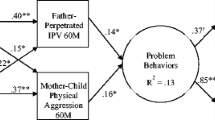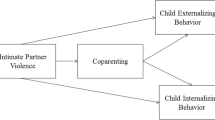Abstract
Little is currently known about father-child contact in families with histories of intimate partner violence (IPV), despite important implications of father contact for these families. The current study of 219 ethnically diverse children aged 6 to 12-years-old and their abused mothers examined relations between father contact, IPV, and children’s internalizing and externalizing problems. Approximately 30 % of the children had no current in-person contact with their father, while another 15 % saw their father every day of the past year. Child internalizing and externalizing problems were positively correlated with frequency of IPV, but unrelated to father contact. Controlling for marital status and mother education, father contact moderated relations between IPV and child externalizing, but not internalizing problems. While father contact was not associated with child adjustment across the entire sample, it did moderate relations between IPV and child behavior problems, suggesting that child contact with a less violent or nonviolent father or father figure might have a buffering effect on behavior problems in children exposed to IPV. Recommendations around father contact in families with IPV are discussed.

Similar content being viewed by others
References
Achenbach, T. M., & Edelbrock, C. S. (1983). Manual for the Child Behavior Checklist and Revised Child Behavior Profile. Burlington: University Associates in Psychiatry.
Baron, R. M., & Kenny, D. A. (1986). The moderator-mediator variable distinction in social psychological research: conceptual, strategic, and statistical considerations. Journal of Personality and Social Psychology, 51, 1173–1182. doi:10.1037/0022-3514.51.6.1173.
Coley, R. L. (2001). (In)visible men: emerging research on low-income, unmarried, and minority fathers. American Psychologist, 56, 743–753. doi:10.1037/0003-066X.56.9.743.
Cookston, J. T., & Finlay, A. K. (2006). Father involvement and adolescent adjustment: longitudinal findings from Add Health. Fathering: A Journal of Theory, Research, and Practice about Men as Fathers, 4(2), 137–158. doi:10.3149/fth.0402.137.
Davies, P. T., Sturge-Apple, M. L., Winter, M. A., Cummings, E. M., & Farrell, D. (2006). Child adaptational development in contexts of interparental conflict over time. Child Development, 77, 218–233. doi:10.1111/j.1467-8624.2006.00866.x.
Dunn, J., O’Connor, T. G., & Cheng, H. (2005). Children’s Responses to conflict between their different parents: mothers, stepfathers, nonresident fathers, and nonresident stepmothers. Journal of Clinical Child and Adolescent Psychology, 34, 223–234. doi:10.1207/s15374424jccp3402_2.
Evans, S. E., Davies, C. A., & DiLillo, D. (2008). Exposure to domestic violence: a meta-analysis of child and adolescent outcomes. Aggression and Violent Behavior, 13(2), 131–140. doi:10.1207/s15374424jccp3402_2.
Fantuzzo, J. W., & Fusco, R. A. (2007). Children’s Direct exposure to types of domestic violence crime: a population-based investigation. Journal of Family Violence, 22, 543–552. doi:10.1007/s10896-007-9105-z.
Fantuzzo, J. W., DePaola, L. M., Lambert, L., Martino, T., Anderson, G., & Sutton, S. (1991). Effects of interparental violence on the psychological adjustment and competencies of young children. Journal of Consulting and Clinical Psychology, 59, 258–265. doi:10.1037/0022-006X.59.2.258.
Featherstone, B., & Peckover, S. (2007). Letting them get away with it: fathers, domestic violence and child welfare. Critical Social Policy, 27, 181–202. doi:10.1177/0261018306075708.
Flouri, E. (2005). Father’s involvement and psychological adjustment in Indian and White British secondary school age children. Child and Adolescent Mental Health, 10(1), 32–39. doi:10.1111/j.1475-3588.2005.00114.x.
Graham-Bermann, S. A., & Seng, J. S. (2005). Violence exposure and traumatic stress symptoms as additional predictors of health problems in high-risk children. Journal of Pediatrics, 146, 349–354. doi:10.1016/j.jpeds.2004.10.065.
Graham-Bermann, S. A., Lynch, S., Banyard, V., Devoe, E., & Halabu, H. (2007). Community based intervention for children exposed to intimate partner violence: an efficacy trial. Journal of Consulting and Clinical Psychology, 75, 199–209. doi:10.1037/0022-006X.75.2.199.
Graham-Bermann, S. A., Gruber, G., Howell, K. H., & Girz, L. (2009). Factors discriminating among profiles of resilient coping and psychopathology in children exposed to domestic violence. Child Abuse & Neglect, 33, 648–660. doi:10.1016/j.chiabu.2009.01.002.
Hamberger, L. K., & Hastings, J. E. (1988). Personality correlates of men who batter and nonviolent men: some continuities and discontinuities. Journal of Family Violence, 6, 131–147. doi:10.1007/BF00978715.
Harne, L. (2004). Childcare violence and fathering—Are violent fathers who look after their children likely to be less abusive? In R. Klein & B. Wallner (Eds.), Gender, conflict and violence. Vienna: Studien-Verlag.
Holden, G. W., & Ritchie, K. L. (1991). Linking extreme martial discord, child rearing, and child behavior problems: evidence from battered women. Child Development, 62, 311–327. doi:10.2307/1131005.
Howell, K. H., Graham-Bermann, S. A., Czyz, E., & Lilly, M. (2010). Assessing resilience in preschool children exposed to intimate partner violence. Violence and Victims, 25, 150–164. doi:10.1891/0886-6708.25.2.150.
Jouriles, E. N., & Norwood, W. D. (1995). Physical aggression toward boys and girls in families characterized by the battering of women. Journal of Family Psychology, 9, 69–78. doi:10.1891/0886-6708.23.2.221.
Katz, L. F., & Windecker-Nelson, B. (2004). Parental meta-emotion philosophy in families with conduct-problem children: links with peer relations. Journal of Abnormal Child Psychology, 32, 385–398. doi:10.1023/B:JACP.0000030292.36168.30.
Katz, L. F., & Windecker-Nelson, B. (2006). Domestic violence, emotion coaching, and child adjustment. Journal of Family Psychology, 20, 56–67. doi:10.1037/0893-3200.20.1.56.
Kuhlman, K. R., Howell, K. H., & Graham-Bermann, S. A. (2012). Physical health in preschool children exposed to intimate partner violence. Journal of Family Violence, 27, 499–510. doi:10.1007/s10896-012-9444-2.
Margolin, G., & Vickerman, K. A. (2007). Posttraumatic stress in children and adolescents exposed to family violence: 1. Overview and issues. Professional Psychology: Research and Practice, 38, 613–619. doi:10.1037/0735-7028.38.6.613.
Marshall, L. (1992). Development of the severity of violence against women scales. Journal of Family Violence, 7, 103–121. doi:10.1007/BF00978700.
McDonald, R., Jouriles, E. N., Ramisetty-Mikler, S., Caetano, R., & Green, C. E. (2006). Estimating the number of American children living in partner-violent families. Journal of Family Psychology, 20, 137–142. doi:10.1037/0893-3200.20.1.137.
National Institute of Child Health and Human Development Early Child Care Research Network. (2004). Father’s and mother’s parenting behavior and beliefs as predictors of child social adjustment in the transition to school. Journal of Family Psychology, 18, 628–638. doi:10.1037/0893-3200.18.4.628.
Osborne, L. N., & Fincham, F. D. (1996). Marital conflict, parent–child relationships, and child adjustment: Does gender matter? Merrill-Palmer Quarterly: Journal of Developmental Psychology, 42(1), 48–75. Retrieved from http://www.jstor.org/stable/23090520
Peled, E. (2000). Parenting by men who abuse women: issues and dilemmas. British Journal of Social Work, 30(1), 25–36. doi:10.1093/bjsw/30.1.25.
Pruett, M. K., Williams, T. Y., Insabella, G., & Little, T. D. (2003). Family and legal indicators of child adjustment to divorce among families with young children. Journal of Family Psychology, 17, 169–180. doi:10.1037/0893-3200.17.2.169.
Rhodes, K. V., Cerulli, C., Dichter, M. E., Kothari, C. L., & Barg, F. K. (2010). “I didn’t want to put them through that”: the influence of children on victim decision-making in intimate partner violence cases. Journal of Family Violence, 25, 485–493. doi:10.1007/s10896-010-9310-z.
Riger, S., Ahrens, C., & Blickenstaff, A. (2000). Measuring interference with employment and education reported by women with abusive partners: Preliminary data. Violence and Victims, 15(2), 161–172. Retrieved from http://search.proquest.com.proxy.lib.umich.edu/docview/208556158?accountid=14667
Roberts, A. R. (1988). Substance abuse among men who batter their mates: the dangerous mix. Journal of Substance Abuse Treatment, 5(2), 83–87. doi:10.1016/0740-5472(88)90017-7.
Salisbury, E. J., Henning, K., & Holdford, R. (2009). Fathering by parent-abusive men: attitudes on children’s exposure to interparental conflict and risk factors for child abuse. Child Maltreatment, 14, 232–242. doi:10.1177/1077559509338407.
Sarkadi, A., Kristiansson, R., Oberklaid, F., & Bremberg, S. (2008). Fathers’ Involvement and children’s developmental outcomes: a review of longitudinal studies. Acta Paediatrica: Nurturing the Child, 97(2), 153–158. doi:10.1111/j.1651-2227.2007.00572.x.
Spaccarelli, S., Sandler, I. N., & Roosa, M. (1994). History of spouse violence against mother: correlated risks and unique effects in child mental health. Journal of Family Violence, 9, 79–98. doi:10.1007/BF01531970.
Sternberg, K. J., Baradaran, L. P., Abbott, C. B., Lamb, M. E., & Guterman, E. (2006a). Type of violence, age, and gender differences in the effects of family violence on children’s behavior problems: a mega-analysis. Developmental Review, 26(1), 89–112. doi:10.1016/j.dr.2005.12.001.
Sternberg, K. J., Lamb, M. E., Guterman, E., & Abbott, C. B. (2006b). Effects of early and later family violence on children’s behavior problems and depression: a longitudinal, multi-informant perspective. Child Abuse & Neglect, 30, 283–306. doi:10.1016/j.chiabu.2005.10.008.
Stover, C. S., Van Horn, P., Turner, R., Cooper, B., & Lierberman, A. F. (2003). The effects of father visitation on preschool-aged witnesses of domestic violence. Journal of Interpersonal Violence, 18, 1149–1166. doi:10.1177/0886260503255553.
Straus, M. A. (1979). Measuring intrafamily conflict and violence: The Conflict Tactics (CT) Scales. Journal of Marriage and the Family, 41(1), 75–88. doi:10.2307/351733.
Straus, M. A., & Gelles, R. J. (1995). Physical violence in American families: Risk factors and adaptations to violence in 8,145 families. New Brunswick: Transaction.
Tjaden, P., & Thoennes, N. (2000). Prevalence and consequences of male-to-female and female-to-male intimate partner violence as measured by the National Violence Against Women Survey. Violence Against Women, 6(2), 142–161. doi:10.1177/10778010022181769.
Wolfe, D. A., Crooks, C. V., Lee, V., McIntyre-Smith, A., & Jaffe, P. G. (2003). The effects of children’s exposure to domestic violence: a meta-analysis and critique. Clinical Child and Family Psychology Review, 6(3), 171–187. doi:10.1023/A:1024910416164.
Zolotor, A. J., Theodore, A. D., Coyne-Beasley, T., & Runyan, D. K. (2007). Intimate partner violence and child maltreatment: overlapping risk. Brief Treatment and Crisis Intervention, 7, 305–321. doi:10.1093/brief-treatment/mhm021.
Author information
Authors and Affiliations
Corresponding author
Rights and permissions
About this article
Cite this article
Hunter, E.C., Graham-Bermann, S.A. Intimate Partner Violence and Child Adjustment: Moderation by Father Contact?. J Fam Viol 28, 435–444 (2013). https://doi.org/10.1007/s10896-013-9517-x
Published:
Issue Date:
DOI: https://doi.org/10.1007/s10896-013-9517-x




